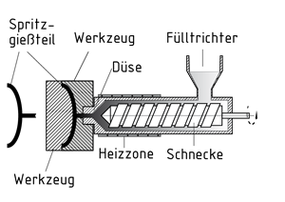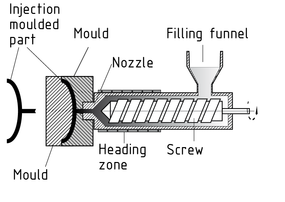
Wählen Sie eine
oder mehrere Sprachen aus
0,1,0
- Deutsch
- Englisch
- Chinesisch
- Spanisch
Spritzgießen

Beim Spritzgießen wird in einer Spritzeinheit eine Gießmasse, meist aus Kunststoff-Granulaten oder Pulver, in einem Heizzylinder plastifiziert und dann unter hohem Druck (80 bis 180 N/mm2) in ein Spritzgießwerkzeug mit geschlossenem Hohlraum (Kavität) eingespritzt. Dort wird die Masse unter Druckeinwirkung verfestigt. Das Spritzgießwerkzeug ist in der Regel bei Thermoplasten gekühlt, bei Duroplasten beheizt. Nachdem der Schnecken- oder Zylinderkolben zurückgefahren ist, wird das Formteil entnommen, dessen Form und Oberflächenstruktur das Werkzeug bestimmt hat.
Spezialformen des Spritzgießens sind:
- Elastomer-Spritzgießen
- Naturfaser-Spritzguss
- Mehrkomponenten-Spritzgießen
- In-Mold-Verfahren
- Pulverspritzgießen (Powder Injection Molding)
- Wasserinjektions-Spritzgießen (Water Injection Technology)
- Schmelzkern-Spritzgießen
- Spritzprägen
- Exjection
- Quellflussprägen
Teile von wenigen Zehntel Gramm bis zu 150 Kilogramm (2013) sind herstellbar. Spritzgießen ist vor allem für Großserienfertigung sinnvoll, weil die Werkzeug-Herstellung kostenintensiv ist.
Injection moulding

During injection moulding, an injection unit is used to plasticise a Casting compound (usually made of plastic granules or powder) in a hot cylinder before it is injected at high pressure (80 to 180 N/mm2) into an injection mould with a closed cavity. Here, the product is solidified under pressure. The injection mould is usually cooled when working with Thermoplastics and heated when using thermosetting materials. Once the reciprocating screw or cylinder piston has been moved back, the moulded part is removed. Its shape and surface structure is determined by the mould.
Special forms of injection moulding include:
- Elastomer injection moulding
- Natural fibre injection moulding
- Multi-component injection moulding
- In-mould process
- Powder injection moulding
- Water injection technology
- Fusible core injection moulding
- Injection compression moulding
- Exjection
- Injection embossing moulding
This process can be used to produce parts weighing anything from a few tenths of a gram up to 150 kg (2013). Injection moulding is primarily suited to mass production, because the mould manufacture process is cost-intensive.
注塑

在注塑工艺中,使用注射装置将一种注模用料(通常由塑料颗粒或粉末制得)增塑至加热圆筒中,然后将其高压 ( 80 至 180 ${N/}mm^2 $ ) 注入到具有封闭空腔的压铸模中。这压铸模中,材料在压力下固化。使用热塑性塑料时,通常冷却压铸模,而使用热固性材料时,通常加热压铸模。一旦往复螺杆或圆筒活塞回位,就可取出模型制品。其形状和表面结构由模具决定。
注塑成型的特殊形式包括:
橡胶注塑
天然纤维注塑
多组分注塑
型内处理法
粉末注塑
注水技术
熔芯注塑
注塑压铸成型
挤注
注塑压花成型
这种工艺可以用来制造从零点几克到 150千克(2013 年)重量范围内的部件。注塑主要适合于大量生产,因为其模具制造过程是低成本的。
注塑
Moldeado por inyección

Durante el moldeado por inyección, se usa una unidad de inyección para plastificar un compuesto de fundición (usualmente hecho de polvo o gránulos de plástico) en un cilindro caliente antes de ser inyectado a alta presión (de 80 a 180 ${N/}mm^2 $ ) en un molde de inyección con una cavidad cerrada. Aquí, el producto es solidificado bajo presión. El molde de inyección es usualmente enfriado cuando se trabaja con termoplásticos y calentado cuando se usan materiales termoestables. Una vez que el tornillo reciprocante o el pistón del cilindro han sido movidos hacia atrás, la pieza moldeada es removida. Su forma y estructura superficial es determinada por el molde.
Entre las formas especiales de moldeado por inyección se incluyen:
Moldeado por inyección de elastómeros
Moldeado por inyección de fibra natural
Moldeado por inyección de componentes múltiples
Proceso en molde
Moldeado por inyección de polvo
Tecnología de inyección de agua
Moldeado por inyección de núcleo fundible
Moldeado por compresión de inyección
Eyección
Moldeado por estampado de inyección
Este proceso puede ser usado para producir piezas pesando desde unos cuantos décimos de gramos hasta 150 kg (2013). El moldeado por inyección es principalmente adecuado para la producción en masa, ya que el proceso de fabricación del molde es costoso.
Moldeado por inyección
